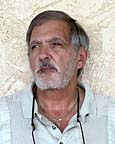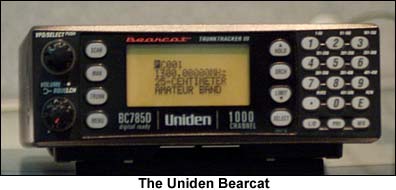Roger Williams
Radio Corner
Police Scanning
in
the New World: 2002
|

|
Police Scanning
in the New World, along with the use of police listening devices by
journalists and the general public, was addressed by the Digital Journalist
in October 1998.
Since that time, many police organizations have implemented systems
to effectively block this invasion, after realizing that "off the
shelf" equipment allowed the listener to invade their communications.
This was first done with "Trunking" systems (described in
the October 1998 Digital Journalist Radio Corner article), and, subsequently,
with APCO 25 digital scanning technology, which surfaced in 2000. The
APCO 25 digital technology system did an effective job of stopping the
police and public service communications invasion -- that is, until
now.
In late 1999 and early 2000, scanners (including the new "Trunking"
listening devices), simply stopped working -- and police and other public
service radio broadcasts effectively disappeared from the airways. The
need for public service privacy was obvious, and multi-fold. Police
departments and other law enforcement agencies found that their own
communications systems were being used for the benefit of the criminal
element. Since the position of police personnel could be tracked, this
information allowed the criminal element to operate with some impunity.
In addition, lawbreakers would sometimes run a diversion, causing police
officers to be drawn away from potential targets, and thus greatly benefiting
the criminals.
As communications systems have improved over time, the listener has
gained increased capability to monitor greater numbers of enforcement
personnel over a larger area. In earlier times, listeners were confined
to a few "repeater" (relay) or radio-to-radio systems, and
were not able to follow large numbers of enforcement personnel with
their equipment. Listening was confined to a very short range, and these
broadcasts rarely enabled the criminal element to successfully benefit
from this information. As "Repeating" improved and "Trunking"
systems came into use, the ability to monitor became department-wide,
and listeners could now monitor department movement over much greater
areas. This was extremely beneficial to those journalists who followed
department movement in order to report crimes, since it reduced the
time required to monitor enforcement personnel and their responses to
criminal movement.
In some cities and counties these days, the monitoring of enforcement
systems, procedures and events of interest to the media has simply disappeared
-- and this will increase as time goes on. Over the last four years,
the monitoring of this activity and the journalist's ability to follow
and report criminal and other activity of interest (drug enforcement,
border problems, etc.), has become virtually nonexistent. The solution?
To develop equipment that effectively followed the new APCO 25 digital
technology system, which was being used to provide enforcement agencies
with a relatively secure communications system. In some areas, the media
was allowed to purchase police radios (listening only), which were programmed
by departments with LIMITED listening capability and cost as much as
$3,000.00 a unit.
 Uniden
Corporation of America has now unveiled a new scanning radio system
which will provide the ability to listen to all the formerly used systems,
and will also enable monitoring of the APCO 25 digital systems. There
will be a mobile/base unit (Bearcat 785D), as well as a hand-held unit
(Bearcat 250). These units will operate as did former units, but they
will have the ability to insert an APCO 25 card (a computer flash card,
similar to those used in modern digital cameras). The problem, however,
will occur in the area of card Uniden
Corporation of America has now unveiled a new scanning radio system
which will provide the ability to listen to all the formerly used systems,
and will also enable monitoring of the APCO 25 digital systems. There
will be a mobile/base unit (Bearcat 785D), as well as a hand-held unit
(Bearcat 250). These units will operate as did former units, but they
will have the ability to insert an APCO 25 card (a computer flash card,
similar to those used in modern digital cameras). The problem, however,
will occur in the area of card
programming. The possession of an APCO 25 card will not, in itself,
allow the unit to monitor APCO 25 systems, since a sophisticated programming
and decoding of the system must first be put on the APCO 25 card. The
danger to the consumer will be to those who purchase the system at a
high cost (the unit and card together are in the $800.00 retail range),
and then find that they cannot use it since the system card has not
been programmed. It is suggested that purchasers of this new equipment
have the system programmed by the seller for their area. Equipment purchased
over the Internet is going to cause great hardship, since the programming
of ANY APCO 25 system is localized, and the purchaser will have great
difficulty getting the system programmed for his own individual needs.
In addition, another problem is APCO 25 card compatibility, since there
may be some areas where the system in use cannot be monitored because
of its particular construction.
Prior to purchasing, therefore, the customer should obtain an agreement
as to the potential usage, along with a guarantee that the purchase
price will be refunded if the system does not work in a certain area
or on a specific system. If the new Bearcat 785D and its hand-held partner
Bearcat 250 are properly programmed for an area using the APCO 25 card
(BCi25D), these units will provide the listener with the ability to
monitor most police and enforcement systems, as well as all existing
systems (including aircraft). The units have an alpha-numeric display
which, if programmed properly, will show a readout of what is being
monitored. They boast a 1000 channel programming capability, and operate
from 25 MHz to 1300 MHz, in 10 banks. Cell phone ranges are continuing
to be deleted, and time will tell if digital cordless phones can also
be monitored. Note, however, that these units in no way allow users
to monitor encrypted signals from national and local security agencies
(CIA, NSA, etc.).
More and more areas, including Los Angeles and San Diego County, have
been migrating to the APCO 25 digital technology over the past few years
-- in order to ensure interoperability among police, fire, EMTs and
other like agencies. As this system becomes more prevalent, news organizations
and media will definitely want to monitor their signals, according to
Uniden spokesman Scott Carpenter in a recent statement at the Las Vegas
Consumer Electronics show.
Feel free to contact me at Radioman@pressroom.com
with any questions on this new technological breakthrough in the ability
to monitor enforcement systems.
Roger Williams
Contributing Writer
|

 Uniden
Corporation of America has now unveiled a new scanning radio system
which will provide the ability to listen to all the formerly used systems,
and will also enable monitoring of the APCO 25 digital systems. There
will be a mobile/base unit (Bearcat 785D), as well as a hand-held unit
(Bearcat 250). These units will operate as did former units, but they
will have the ability to insert an APCO 25 card (a computer flash card,
similar to those used in modern digital cameras). The problem, however,
will occur in the area of card
Uniden
Corporation of America has now unveiled a new scanning radio system
which will provide the ability to listen to all the formerly used systems,
and will also enable monitoring of the APCO 25 digital systems. There
will be a mobile/base unit (Bearcat 785D), as well as a hand-held unit
(Bearcat 250). These units will operate as did former units, but they
will have the ability to insert an APCO 25 card (a computer flash card,
similar to those used in modern digital cameras). The problem, however,
will occur in the area of card